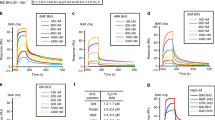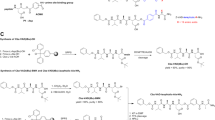Abstract
The inhibitor-of-apoptosis (IAP) family of proteins, originally identified in baculoviruses1, regulate programmed cell death in a variety of organisms2,3,4,5,6. IAPs inhibit specific enzymes (caspases) in the death cascade7,8,9,10,11 and contain one to three modules of a common 70-amino-acid motif called the BIR domain12. Here we describe the nuclear magnetic resonance structure of a region encompassing the second BIR domain (BIR2) of a human IAP family member, XIAP (also called hILP or MIHA). The structure of the BIR domain consists of a three-stranded antiparallel β-sheet and four α-helices and resembles a classical zinc finger13. Unexpectedly, conserved amino acids within the linker region between the BIR1 and BIR2 domains were found to be critical for inhibiting caspase-3. The absence or presence of these residues may explain the differences in caspase inhibition observed for different truncated and full-length IAPs10,11. Our data further indicate that these residues may bind to the active site and that the BIR domain may interact with an adjacent site on the enzyme.
This is a preview of subscription content, access via your institution
Access options
Subscribe to this journal
Receive 51 print issues and online access
$199.00 per year
only $3.90 per issue
Buy this article
- Purchase on Springer Link
- Instant access to full article PDF
Prices may be subject to local taxes which are calculated during checkout



Similar content being viewed by others
References
Crook,N. E. Clem,R. J. & Miller,L. K. An apoptosis-inhibiting baculovirus gene with a zinc finger-like motif. J. Virol. 67, 2168–2174 (1993).
Hay,B. A., Wassarman,D. A. & Rubin,G. M. Drosophila homologs of baculovirus inhibitor of apoptosis proteins function to block cell death. Cell 83, 1253–1262 (1995).
Roy,N. et al. The gene for neuronal apoptosis inhibitory protein is partially deleted in individuals with spinal muscular atrophy. Cell 80, 167–178 (1995).
Duckett,C. S. et al. A conserved family of cellular genes related to the baculovirus iap gene and encoding apoptosis inhibitors. EMBO J. 15, 2685–2694 (1996).
Uren,A. G., Pakusch,M., Hawkins,C. J., Puls,K. L. & Vaux,D. L. Cloning and expression of apoptosis inhibitory protein homologs that function to inhibit apoptosis and/or bind tumor necrosis factor receptor-associated factors. Proc. Natl Acad. Sci. USA 93, 4974–4978 (1996).
Ambrosini,G., Adida,C. & Altieri,D. C. A novel anti-apoptosis gene, survivin, expressed in cancer and lymphoma. Nature Med. 3, 917–921 (1997).
Hawkins,C. J., Uren,A. G., Hacker,G., Medcalf,R. L. & Vaux,D. L. Inhibition of interleukin 1β-converting enzyme-mediated apoptosis of mammalian cells by baculovirus IAP. Proc. Natl Acad. Sci. USA 93, 13786–13790 (1996).
Deveraux,Q. L., Takahashi,R., Salvesen,G. S. & Reed,J. C. X-linked IAP is a direct inhibitor of cell-death proteases. Nature 388, 300–304 (1997).
Roy,N., Deveraux,Q. L., Takahashi,R., Salvesen,G. S. & Reed,J. C. The c-IAP-1 and c-IAP-2 proteins are direct inhibitors of specific caspases. EMBO J. 16, 6914–6925 (1997).
Takahashi,R. et al. A single BIR domain of XIAP sufficient for inhibiting caspases. J. Biol. Chem. 273, 7787–7790 (1998).
Tamm,I. et al. IAP-family protein survivin inhibits caspase activity and apoptosis induced by Fas(CD95), Bax, caspases, and anti cancer drugs. Cancer Res. 58, 5315–5320 (1998).
Uren,A. G., Coulsen,E. J. & Vaux,D. L. Conservation of baculovirus inhibitor of apoptosis repeat proteins (BIRPs) in viruses, nematodes, vertebrates and yeasts. Trends Biochem. Sci. 23, 159–162 (1998).
Schwabe,J. W. R. & Klug,A. Zinc mining for protein domains. Nature Struct. Biol. 1, 345–349 (1994).
Hansen,M. R., Mueller,L. & Pardi,A. Tunable alignment of macromolecules by filamentous phage yields dipolar coupling interactions. Nature Struct. Biol. 5, 1065–1074 (1998).
Clore,G. M., Starich,M. R. & Gronenborn,A. M. Measurement of residual dipolar couplings of macromolecules aligned in the nematic phase of a colloidal suspension of rod-shaped viruses. J. Am. Chem. Soc. 120, 10571–10572 (1998).
Thornberry,N. A. et al. A combinatorial approach defines specificities of members of the caspase family and granzyme B. J. Biol. Chem. 272, 17907–17911 (1997).
Rotunda,J. et al. The three-dimensional structure of apopain/CPP32, a key mediator of apoptosis. Nature Struct. Biol. 3, 619–625 (1996).
Hinds,M. G., Norton,R. S., Vaux,D. L. & Day,C. L. Solution structure of a baculoviral inhibitor of apoptosis (IAP) repeat. Nature Struct. Biol. 6, 648–651 (1999).
Clore,G. M. & Gronenborn,A. M. Multidimensional heteronuclear nuclear magnetic resonance of proteins. Methods Enzymol. 239, 349–363 (1994).
Neri,D., Szyperski,T., Otting,G., Senn,H. & Wüthrich,K. Stereospecific nuclear magnetic resonance assignments of the methyl groups of valine and leucine in the DNA-binding domain of the 434 repressor by biosynthetically directed fractional 13C labeling. Biochemistry 28, 7510–7516 (1989).
Vuister,G. W. & Bax,A. Quantitative J correlation: A new approach for measuring homonuclear three-bond J (HNHα) coupling constants in 15N-enriched proteins. J. Am. Chem. Soc. 115, 7772–7777 (1993).
Hu,J.-S., Grzesiek,S. & Bax,A. Two-dimensional NMR methods for determining χ1 angles of aromatic residues in proteins from three-bond JC′Cγ and JNCγ couplings. J. Am. Chem. Soc. 119, 1803–1804 (1997).
Cornilescu,G., Delaglio,F. & Bax,A. Protein backbone angle restraints from searching a database for chemical shift and sequence homology. J. Biomol. NMR 13, 289–302 (1999).
Stein,E. G., Rice,L. M. & Brünger,A. T. Torsion angle molecular dynamics: a new efficient tool for NMR structure calculation. J. Magn. Reson. Ser. B 124, 154–164 (1997).
Nilges,M., Gronenborn,A. M., Brünger,A. T. & Clore,G. M. Determination of three-dimensional structures of proteins by simulated annealing with interproton distance restraints: application to crambin, potato carboxypeptidase inhibitor and barley serine proteinase inhibitor 2. Protein Eng. 2, 27–38 (1988).
Brünger,A. T. X-PLOR 3.1 Manual (Yale Univ. Press, New Haven, 1992).
Tjandra,N., Omichinski,J. G., Gronenborn,A. M., Clore,G. M. & Bax,A. Use of dipolar 1H–15N and 1H–13C couplings in the structure determination of magnetically oriented macromolecules in solution. Nature Struct. Biol. 4, 732–738 (1997).
Rance,M., Loria,J. P. & Palmer,A. G. III Sensitivity improvement of transverse relaxation-optimized spectroscopy. J. Magn. Res. 136, 92–101 (1999).
Pervushin,K., Riek,R., Wider,G. & Wüthrich,K. Attenuated T2 relaxation by mutual cancellation of dipole–dipole coupling and chemical shift anisotropy indicates an avenue to NMR structures of very large biological macromolecules in solution. Proc. Natl Acad. Sci. USA 94, 12366–12371 (1997).
Carson,M. J. Ribbon models of macromolecules. J. Mol. Graphics 5, 103–106 (1987).
Acknowledgements
We thank R. Mendoza for technical assistance; A. Pardi for the starter cultures of Pseudomonas aeruginosa and Pf1 phage; M. Clore for a modified version of the X-PLOR program; F. Delaglio and A. Bax for the TALOS program; and J. Wu from IDUN Pharmaceuticals for the caspase-3 clone.
Author information
Authors and Affiliations
Corresponding author
Rights and permissions
About this article
Cite this article
Sun, C., Cai, M., Gunasekera, A. et al. NMR structure and mutagenesis of the inhibitor-of-apoptosis protein XIAP. Nature 401, 818–822 (1999). https://doi.org/10.1038/44617
Received:
Accepted:
Issue Date:
DOI: https://doi.org/10.1038/44617
This article is cited by
-
Understanding the molecular mechanism of pathogenic variants of BIR2 domain in XIAP-deficient inflammatory bowel disease
Scientific Reports (2024)
-
A Review on Caspases: Key Regulators of Biological Activities and Apoptosis
Molecular Neurobiology (2023)
-
XIAP as a multifaceted molecule in Cellular Signaling
Apoptosis (2022)
-
Targeting Apoptosis in Cancer
Current Oncology Reports (2022)
-
WX20120108, a novel IAP antagonist, induces tumor cell autophagy via activating ROS-FOXO pathway
Acta Pharmacologica Sinica (2019)
Comments
By submitting a comment you agree to abide by our Terms and Community Guidelines. If you find something abusive or that does not comply with our terms or guidelines please flag it as inappropriate.



